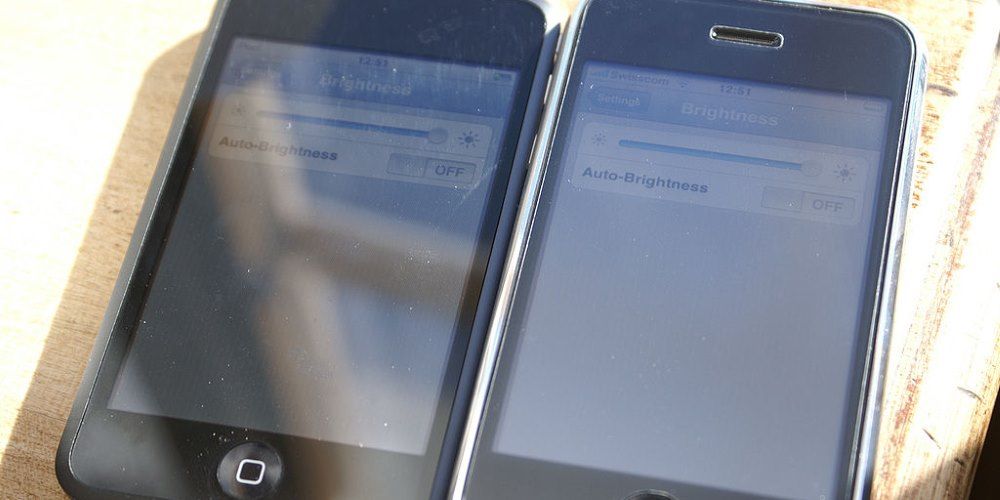If you're experiencing the symptoms of eye strain, the best solution is to spend less time looking at screens. However, if you can't afford to take your eyes off of your monitor, there are ways to reduce the effect they have on your eyes,
Here are a few ways where a new purchase can reduce monitor eye strain.
1. New Monitors May Feature DC Dimming
Your monitor is likely made up of lots of little Light Emitting Diodes (LEDs). To preserve your eyes, these LEDs can be dimmed to reduce the light they emit.
There are two different ways that LEDs are dimmed: via pulse width modulation (PWM) or direct current (DC). In PWM, the LEDs are turned on and off very rapidly, and the more time they spend in the "off" mode, the dimmer they appear.
PWM has been used in LED monitors for a long time, and it works well. Unfortunately, it can also cause flickering, which can strain the eyes. It's especially noticeable when your monitor is at very low levels of brightness.
DC dimming takes a different approach. Instead of turning the LEDs on and off at full power, it regulates the power going into the diodes. When there's less power flowing through, the LEDs aren't as bright. As a result, there's no flickering.
Many modern monitors have DC dimming (you'll sometimes see it labeled as "PWM-free"). It was once an expensive addition and would burn out the LEDs faster. However, as technology has improved, it's gotten easier to find monitors with DC dimming.
2. New Monitors Feature Automatic Brightness Adjustment
Monitors that are too bright can cause eye strain. While it's fairly easy to adjust the brightness yourself, lots of new monitors come with automatic brightness adjustment. If you've used one of the backlit Kindles, you've seen this feature before.
These monitors include light sensors and always adjust the brightness to an optimum level. Some even let you customize how they work. It saves you a step and keeps you from forgetting to make the adjustment yourself.
If your monitor doesn't have brightness adjustment, there are ways to replicate it on the software level. For instance, there's both Windows 10's night light and f.lux, both of which we compared in our guide on f.lux vs. Windows 10.
3. Some Monitors Have Glare Reduction
If your monitor is glossy and tends to reflect a lot of light, your eyes are doing more work than they need to. Glare and reflections make it hard to focus and add to eye strain from monitors. Fortunately, it's easy to find monitors with anti-glare coatings.
There are full-matte monitors, but these tend to look a little washed out. Semi-glossy and coated screens reduce glare without making it difficult to see details. These are perfect for offices or desks that get some sunlight or tend to reflect overhead lights.
It's getting more difficult to find a monitor without glare reduction or anti-reflective coating, but make sure to double-check when you're shopping around.
4. Curved Screen Monitors Are More Readily Available Now
Curved screens are increasingly common. It can take a while to get used to a curved monitor, as they curve around your head for a more immersive experience.
But are curved monitors better for your eyes? They feel strange at first, and you might feel like it's actually making your eyes do more work. However, research tells us the opposite is true.
As your eyes shift from the center to the peripheries of a flat-screen, the distance between your eyes and the screen changes, requiring you to quickly refocus. If you regularly perform actions that require your eyes to move back and forth between the center and the side of your screen, it causes a lot of refocusing.
A curved screen keeps the focal distance more uniform, obviating the need for countless quick refocuses. As such, when you're shopping for a curved vs. a flat monitor, be sure to check out the former for better eye focus.
5. New Monitors Can Emit Less Blue Light
Some monitor manufacturers are taking steps to reduce eye strain by limiting the amount of blue light emitted by their screens. BenQ, for example, has some cool blue-light filtering tech in their monitors:
ASUS also has a line of eye care monitors that emit less blue light. Of course, there are other good ways to limit blue light.
Windows 10 has a built-in feature to do the same thing. Mac users can take advantage of a similar feature with Night Shift, while macOS Mojave offers a dark mode for your apps which also helps reduce eye-strain.
It takes a bit to get used to the very red-looking screen, but it's been shown to make a difference and we recommend it!
6. New Monitors Offer Increased Adjustability
Older monitors, especially really old CRTs, had almost no adjustability. But you can easily adjust the height, viewing angle, and even orientation of modern monitors. Getting a monitor at the right angle is crucial for a comfortable workplace.
According to ErgoBuyer, the best viewing angle is between 20 and 50 degrees below horizontal. Interestingly, looking straight ahead at your monitor is good for your neck, but places additional strain on your eyes.
They point out that this angle below horizontal is similar to the angle used when people read books---so think of it that way when you're setting up your workstation.
Is It Time to Invest in a New Monitor?
If it's been a long time since you last upgraded your monitor, it might be time. Especially if you spend hours looking at your screen every day. Many of the features listed above might seem pretty minor. But they make a difference, especially if your old monitor only had one or two of them.
If you think you have eye strain, there are some symptoms to keep your eye out for (no pun intended). Knowing the early warning signs can help you tackle the problem before it gets too out of hand.
Image Credit: ridofranz/Depositphotos


